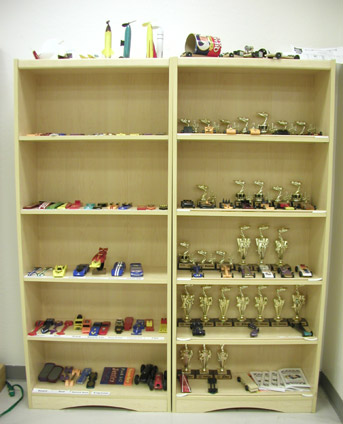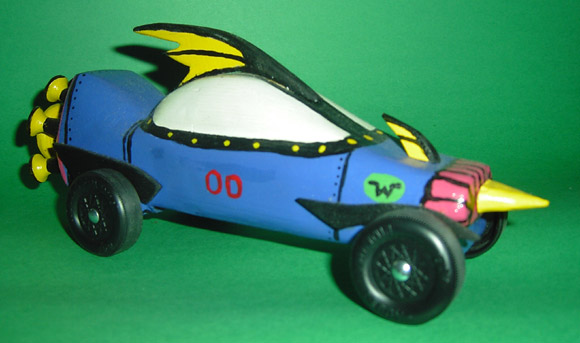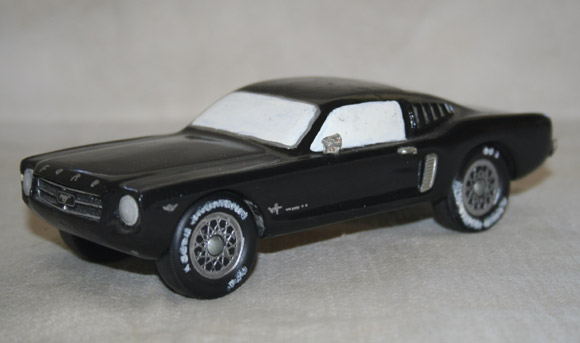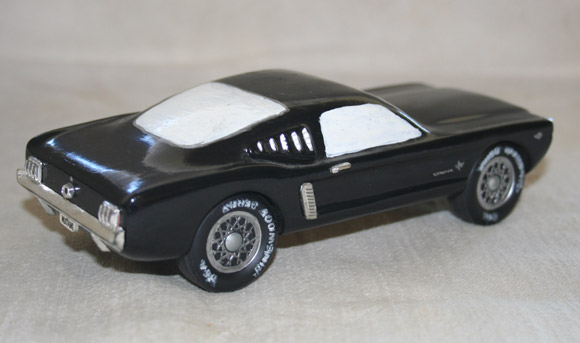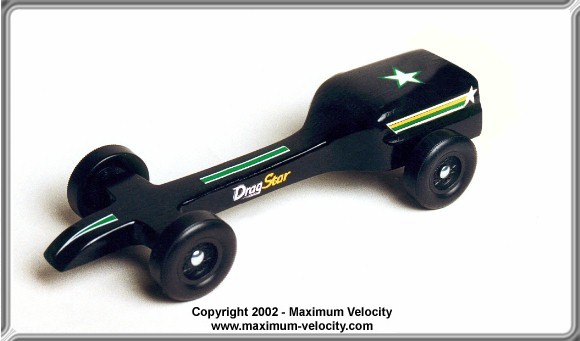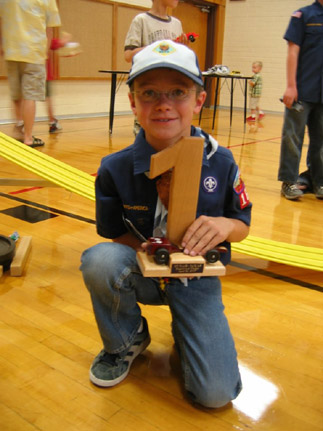– Feature Article – Maximum Velocity History and Photo Tour
– Pinewood Derby Car Showcase
– Memory – The Derby
– Q&A
Maximum Velocity History and Photo Tour
When in a social situation, a common question that is asked is, “What do you do?” When I answer, “I sell pinewood derby cars”, the usual response is “You’re kidding!?” Then after a little explanation about Maximum Velocity, I am usually asked something like, “How did you get started?”
So, I thought I would share with you how Maximum Velocity started, and also provide a virtual tour of our facility.
History
Although, my memory is a bit hazy, I believe my first experience with pinewood derby racing was when my son was 6 years old. I was not particularly enthused with the project, but I helped him build a car for the event. It wasn’t much to look at, only weighed 4.9 ounces, and was lubed with a drop of silicone oil (the only redeeming factor).
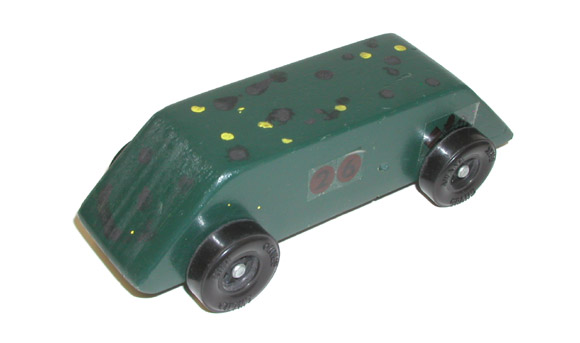
The car was not particularly fast, but the race was organized in a strange way. All of the cars were raced to determine first place in each of the age categories. Then all of the remaining cars were re-run to determine second and third. Due to the number of cars, and some technical issues, the race dragged on for hours. As the time went well past the bedtime of my son and his competitors, many of them called it quits and went home. So, when it came time for my son’s car to race, there were few competitors remaining, and his car took third place. He was thrilled (and so was I)!
The next year, I was much more enthused, but I used a poor lubricant, and the cars did poorly. I felt bad for my kids (two involved that year), so I swore the next year would be different.
The next year, after some research, our cars did do better. But more to the point, I had helped at the check-in by adding weight to the cars with melted lead. By the end of the evening, my nerves were shot from avoiding burns, concern with damaging cars, and dealing with parents that wanted that last tenth of an ounce of lead added to the car. It was time for a change.
So, when 1997 rolled around I convinced the club leader that the parent-child team needed to add their own weight, and that to help them I would write and distribute a pamphlet with speed tips. This booklet was the first edition of “Speed to the Finish”, although it was not titled as such at the time. During the next two years, the booklet underwent many changes, and started to take its current format.
After the 1999 race, a friend suggested that I offer the booklet on the Internet (Internet retailing was just getting popular at the time). So in late 1999, www.maximum-velocity.com was launched with the speed tip booklet as the only product. We didn’t sell very many booklets that year, but enough to realize that there was some potential in the market.
In 2000, we introduced the booklets, “Car plans” and “Advanced Car Plans”. In 2001, we introduced additional booklets, automatic downloading, and several weight products. The business was starting to take shape.
Up to this point, Maximum Velocity was a part-time endeavor, ran out of our house by my wife Elisa and I. I had been telecommuting for a Houston-based company for two years, when it became apparent that a change was coming; either we would need to move to Houston, or find another job.
After much soul-searching, budget-planning, and prayer, we decided to give entrepreneurship a go. Providentially, this was when Bill Launius (DerbyWorx) came up with his first tool, the Pro-Hub Tool, followed shortly after by the Pro-Axle Press and Pro-Body Tool. With the introduction of these tools, some car kits, and various other products, the first full-time season (2002-03) was a success. This was followed by a great 2003-04 season.
At this point, we realized that more space was needed. We first attempted to find a house that would accommodate the business. But then we found a commercial space for rent that was virtually perfect for our needs. So, during the summer of 2004, we moved into our current location.
Store Tour

Our facility is located in a small business park in Peoria, Arizona. As the majority of our business is Internet-based, the store is set up as shipping facility (however, walk-ins are welcome).
When you enter the door, you are greeted by the racks of inventory, and the packing area (the big blue thing is a packing peanut dispenser). During the busy season, this area is worked by some full and part-time employees.
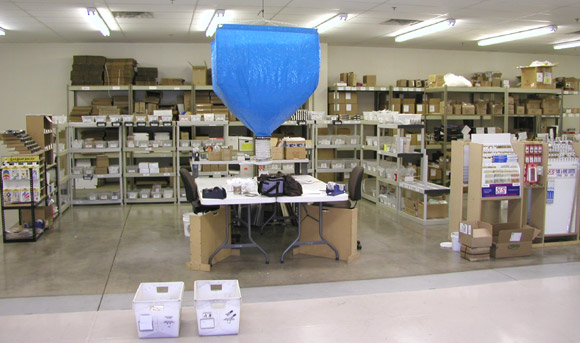
Behind this area is our racks of bulk inventory, boxes, and other packing material.
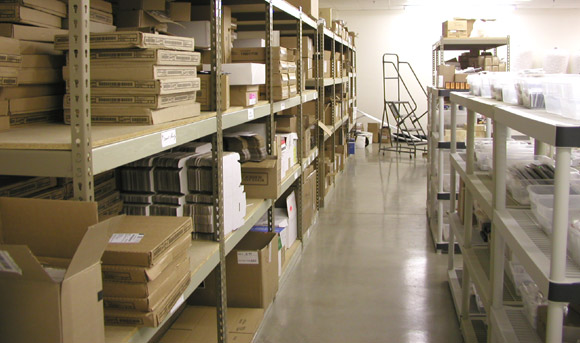
Here is a half-used pallet of blocks for our MV Basic Car Kits. We go through a lot of blocks!
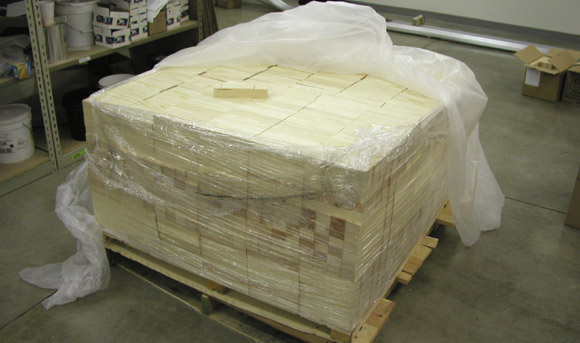
Near the right-hand wall (below the packing peanuts) is where two tracks are located. The photo shows the end of the 35 foot BestTrack, and the start of the 32 foot Freedom track. Also shown is a wheel alignment board (and a rain gutter for regatta racing).
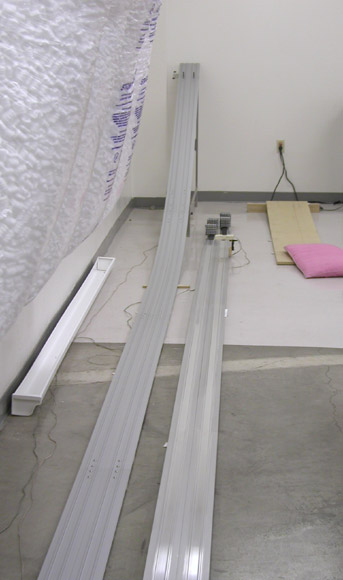
To the right of the front entrance is our shelves of cars. The left hand side contains models of the cars in our car plans booklets. The right hand side contains our kid’s cars (less the ones they have at home). On top are boats, space ships, and propeller-driven cars.
Car Shelves
To the left of the front door is our lathe area. My favorite lathe is a Taig. It is a simple lathe that works great for wheel work. I also use it for polishing axles.
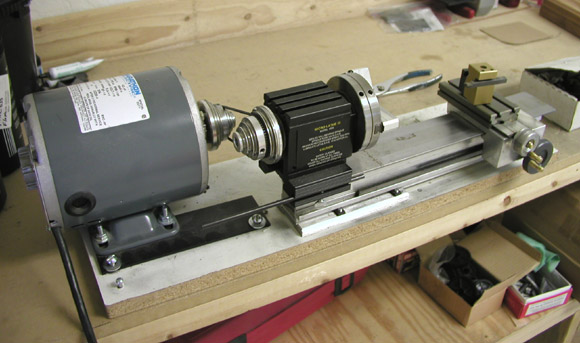
The other lathe is a MicroLux. Originally it was used for Speed Wheel and Axle production. Now that work is contracted to a machinist. So this lathe doesn’t get much use, but as it has a feed control I find occasional use for it.
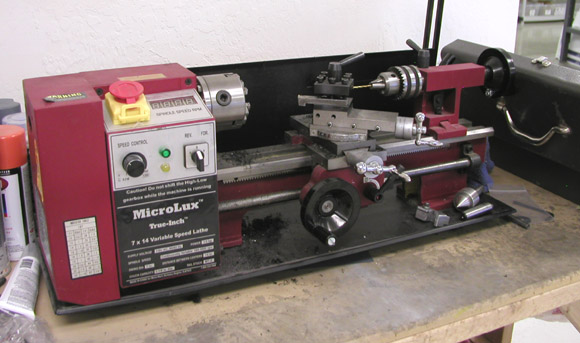
Finally our wood shop area contains three drill presses, a band saw, a dual-bladed table saw, a mortising machine, a shaper, a chop saw, a spindle sander, an edge sander, and a dust collection system. We also have a CNC router, which is not shown in this photo. All of our car kits are produced in this area.
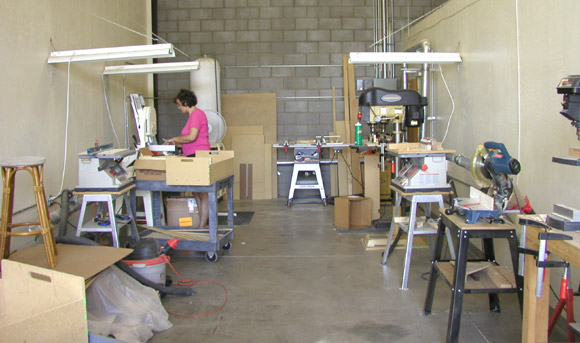
Final Thoughts
As in any business, there have certainly been ups and downs, but we have never been sorry that we started this business. I was always a jack of all trades, so entrepreneurship suits me just fine. I hope that God grants me the energy and health to keep up the pace so that we can help pinewood derby participants for many more seasons. If you are ever in the Phoenix area, please do drop by for a visit.
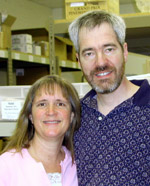
Pinewood Derby Car Showcase
Dick Dastardly’s Mean Machine: Frank Tonra
Dick Dastardly’s Mean Machine is from the Saturday morning cartoon “The Wacky Races” of the late 60’s. Each year I make a pace car to test run the track so as not to wreck any scouts cars. First, I made a 3-D tiger car, then the Batmobile, and last year the Mean Machine. The car uses a BSA block with a few small draw knobs and a craft plant pot. The fins are balsa wood cut outs. Building this car was hours of fun, fun, fun!
Mustang: Rylan Darr
Here is our favorite Gulf Ridge Council winning design car. The Mustang 2+2 was built by Rylan in 2005 to compete in the Classic Car design category. He wanted to make a car just like his dad’s car in the garage. So we designed it together, cut it with a band saw, Dremel’ed out all of the contours, and sanded it smooth before applying a layer of primer and four layers of Black enamel paint. For added realism we removed the grill, lights, mirrors, door handles, and gas cap from a die cast Mustang and placed them on his car. The hood lettering and emblems were painted on by hand with a very fine brush. The finished product made him glow with excitement. It was not a fast car but it sure looked beautiful going down the track. I think that one day he may just have his own real mustang that he will restore like me. He sure is off to a good start.
Pinewood Derby Memory
The Derby
Every year an elaborate ritual is observed, a rite of passage for young boys and their fathers — a test of sorts — the pinewood derby!
It is a test on several fronts: the boys are tested to see if they can follow directions (cutting, sanding, painting, etc.), the fathers are tested (Do I buy a pre-cut model? Do we do it from scratch? Do I make the boy do more? How do I make sure we win?), and even the mothers are tested (Why are they spending so much time on this? Why didn’t they start earlier?). The result is grueling weeks of competing interests and the final outcome — The Race. The race is the culmination of the preparation (or lack thereof) haste or deliberation, purchased goods or paying the price; it all comes through.
So without further ado, here is the story of the 2007 Pinewood Derby.
One month before the race: “Hi Dad. I got my pinewood derby car today at scouts. When can we start? I was thinking tonight.”
Two weeks before the race: “Hi Dad. Is it time to start the pinewood derby car yet?”
One week before the race: “Dad, the pinewood derby is next Saturday!”
And thus the mad rush begins. We first go scouting for a blueprint, for we are not girly-types who buy precut models from the store. Benjamin and I find the website: www.maximum-velocity.com. After searching through all the blueprints, Benjamin narrows the field to:
Our course is set; we now have to build one of the most difficult cars they sport in one week. We need to get more tools! Off to Home Depot we go to get special drill bits, the right sand paper, and various other tools that can be excused away to making a good pinewood derby car.
After cutting out the patterns and tracing them on the pine block (and missing the first crucial step of aligning the wheel grooves), the wood cutting begins. Because of the design, a coping saw is used (which makes for really fun sanding later, let me tell you!).
Once the model is complete, the back end of the car is drilled out to specifications for the weights, which we purchased from Michael’s. First lesson in chemistry: zinc does not weigh the same as lead! We try not to panic as the weights we purchased will never fit in the given area, even though we hollowed it out so much that the back had to be glued back together because it got too thin and cracked.
On contacting Maximum Velocity, they pointed out the difference between zinc and lead, and graciously sent us the correct materials overnight (for a small fee of course). We’re now down to three days before the race.
After several nights of sanding and gluing, weighing, frantically drilling out lead to reduce the weight, drilling out more lead weight to account for the wood filler that must be added to plug the hole, we finally have a fuselage. The painting process yields several new lessons learned about how hairdryers cause bubbles to appear in paint if used too close.
Because we’re now down to the last minute, we make the decision (at Dad’s suggestion) to take the carefully crafted wheels and axles from last year’s 2nd place car and make a few minor improvements for this year’s car. A polish here, an extra sanding there, and we’re in business.
Until the weigh-in. Ooooops, the car is 4.9 ounces (max is 5.0 and most boys are right there). “It’s okay”, I tell Ben. Weight is important, but weight distribution and lack of friction on the wheels wins the day.
So, when the big day arrives Ben has a cool, calm, and collected smile. The price has been paid, and now the fun can begin. If we don’t win (after Dad’s sleep deprivation-induced breakdown) everything will be okay. We did our best (given the time).
So, what do you think happened? Did Ben Win?
The way the races are run, a tally is kept of number of wins, and each boy competes against each other boy. There are 20 boys racing. Towards the end of the races, there are three clear winners, and Ben is one of them. And then … DISASTER STRIKES!
On Benjamin’s last race before the finals, after his car crosses the finish line in first place, the wood holding the front left wheel in place snaps clean off! I tend to think that some little kid near the finish line put their hand down (there were many crowding around) and scrunched it, but I’m assured by someone I trust who was there that it just came off. The only thing we can figure out is that because the axle slots were not perfectly parallel, the car did bump a little as it went down the track. This shimmying must have finally broken the slender wheel post. We were in big trouble; this was a fatal blow from which it seemed impossible that we could recover. I picked up the broken pieces and putting on my best face said to Benjamin’s concerned look. “We’ll do what we can. Come on, let’s go.”
As we walked away from the track, another dad mentioned that he had some epoxy glue. It was the kind that takes 5 minutes to set (and then it’s not full strength for a while) and we did not have 5 minutes. We had about two. But we would give it a go. But before I could get the glue completely mixed, Ben’s former Wolf leader dropped by our sad little camp with a small tube of liquid hope — Superglue.
It might just work, and we have nothing but to try. A quick application, a desperate vise grip, the clock ticking the seconds away when suddenly, our time is up. Benjamin’s name is being called and there is no more time.
The moment of truth has arrived. Benjamin takes the car to the track’s start and I quickly run to the finish line to instruct the car stopper person to please take it easy on the car. I figure if we make it through one race, which would be a miracle, at least he should be careful so that maybe we can race again.
The first race, Ben wins! The second race, Ben wins again, but in order to beat this guy, he’s got to beat him twice! The crowd starts chanting Benjamin’s number (and I start feeling sorry for the other boy, but the crowd is out of control and there is no stopping them now).
Eight, eight, eight, eight, eight, eight, EIGHT, EIGHT, the crowd chants, reaching a fevered pitch as the cars are placed on the track. Both boys race down to the end of the track as if they are the cars. Everyone holds their breath with one question on their minds: “Will Ben’s car break up into pieces or win the day?” Anything could happen!
A picture is worth a thousand words. So next year, instead of a long drawn out commentary, I’ll just post the picture.
By John Thomas
Q&A
Is there any way to keep axles straight when first inserting then other than using a hammer?
If you are using axle slots, then you can either use the Pro-Body Tool to pilot hole the slots, and then use the Pro-Axle Guide to press them in (place the axle head on a firm work surface, and press the body down against the axle). If you are confident that the slots are square, you can skip the Pro-Body Tool step, but much more force will be required to insert the axles the first time.
If you are using axle holes, then you can press them in as above. If the holes are too tight, then first hand ream the holes with a #44 drill bit.
Someone told me that they “dip the body” in light epoxy to give it strength. Have you ever heard of that, and if so, what do you use?
Epoxy products can be used to give a hard coat to the body. This does help minimize dings, but the main benefit is that it provides a good paint base. The wood pores are sealed so they won’t show through. Check with a local hobby shop for this type of product. These products are commonly used to coat balsa or foam for use in R/C airplanes. Just beware that these products usually produce strong, toxic fumes. So you need to use them in a well-ventilated area with breathing protection.
Your mold number chart changes from year to year. Why is that?
The molds from which the wheels are made do change from time-to-time. My understanding is that the molds eventually wear out and must be replaced. As this occurs, the characteristics of that mold number changes.
Want Answers?
Do you have a pinewood derby-related question? If so, e-mail us your question.We answer all questions by e-mail, but not every question will appear in the Q&A section of the newsletter.
Back Issues
Are you a new subscriber, or have you missed some of the previous newsletters? Don’t miss out; all of the issues for Volume 5 through Volume 17 are posted on our web site.
Newsletter Contributions
We welcome your contributions. If you would like to contribute an article, a web site review, a speed tip, or a pinewood derby memory, please e-mail us.
Subscription Information
The Pinewood Derby Times is a free e-newsletter focused on pinewood derby racing. It is published biweekly from October through March.
If you haven’t already done so, please forward this issue to your pinewood derby friends. But please don’t subscribe your friends. Let them decide for themselves. Thanks.
If this newsletter was forwarded to you, why not subscribe to receive this newsletter. There is no cost, and your e-mail address is safe, as we never sell or share our distribution list.
To subscribe, send a blank e-mail to
[email protected]
You will receive a confirmation e-mail. Reply to the confirmation e-mail and you will start receiving the Pinewood Derby Times with the next issue.
Randy Davis, Editor, Pinewood Derby Times
E-Mail: [email protected]
(C)2018, Maximum Velocity, Inc. All rights reserved. Please do not reprint or place this newsletter on your web site without explicit permission. However, if you like this newsletter we grant permission, and encourage you to e-mail it to a friend.
Maximum Velocity disclaims any personal loss or liability caused by utilization of any information presented in this newsletter.
The Pinewood Derby Times is not specific to, and is not affiliated with the Boy Scouts of America, YMCA, Awana, or any other organization.
(R)Maximum Velocity is a registered trademark of Maximum Velocity, Inc.
(R)Pinewood Derby is a registered trademarks of the Boys Scouts of America.
(R)Awana is a registered trademark of Awana Clubs International.
All other names are trademarks of their respective owners.

